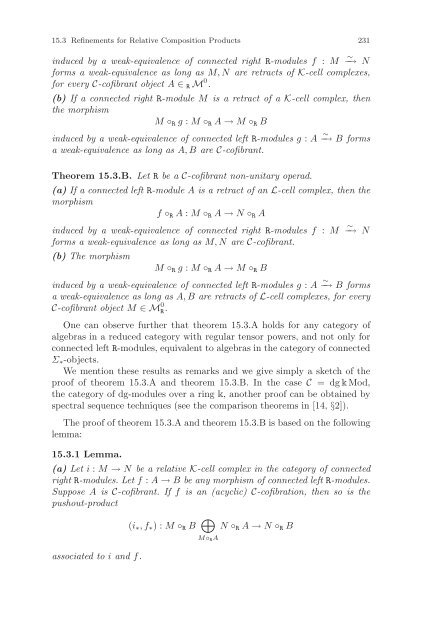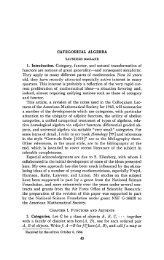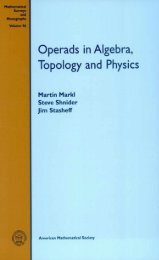- Page 2 and 3:
Lecture Notes in Mathematics 1967 E
- Page 4 and 5:
Benoit Fresse UFR de Mathématiques
- Page 6 and 7:
vi Preface Γ -object, which occur
- Page 8 and 9:
viii Contents 9 Algebras in Right M
- Page 10 and 11:
Introduction Main Ideas and Objecti
- Page 12 and 13:
Introduction 3 The category of Σ
- Page 14 and 15:
Introduction 5 the bar module BC to
- Page 16 and 17:
Introduction 7 modules over envelop
- Page 18 and 19:
Introduction 9 to a P-algebra in ri
- Page 20 and 21:
Introduction 11 DerP(A, E). There i
- Page 22 and 23:
Introduction 13 In both contexts (m
- Page 24 and 25:
22 1 Symmetric Monoidal Categories
- Page 26 and 27:
24 1 Symmetric Monoidal Categories
- Page 28 and 29:
26 1 Symmetric Monoidal Categories
- Page 30 and 31:
28 1 Symmetric Monoidal Categories
- Page 32 and 33:
30 1 Symmetric Monoidal Categories
- Page 34 and 35:
32 1 Symmetric Monoidal Categories
- Page 36 and 37:
34 1 Symmetric Monoidal Categories
- Page 38 and 39:
36 2 Symmetric Objects and Functors
- Page 40 and 41:
38 2 Symmetric Objects and Functors
- Page 42 and 43:
40 2 Symmetric Objects and Functors
- Page 44 and 45:
42 2 Symmetric Objects and Functors
- Page 46 and 47:
44 2 Symmetric Objects and Functors
- Page 48 and 49:
46 2 Symmetric Objects and Functors
- Page 50 and 51:
48 2 Symmetric Objects and Functors
- Page 52 and 53:
50 2 Symmetric Objects and Functors
- Page 54 and 55:
52 2 Symmetric Objects and Functors
- Page 56 and 57:
54 3 Operads and Algebras in Symmet
- Page 58 and 59:
56 3 Operads and Algebras in Symmet
- Page 60 and 61:
58 3 Operads and Algebras in Symmet
- Page 62 and 63:
60 3 Operads and Algebras in Symmet
- Page 64 and 65:
62 3 Operads and Algebras in Symmet
- Page 66 and 67:
64 3 Operads and Algebras in Symmet
- Page 68 and 69:
66 3 Operads and Algebras in Symmet
- Page 70 and 71:
68 3 Operads and Algebras in Symmet
- Page 72 and 73:
70 3 Operads and Algebras in Symmet
- Page 74 and 75:
72 3 Operads and Algebras in Symmet
- Page 76 and 77:
74 3 Operads and Algebras in Symmet
- Page 78 and 79:
76 3 Operads and Algebras in Symmet
- Page 80 and 81:
78 4 Miscellaneous Structures Assoc
- Page 82 and 83:
80 4 Miscellaneous Structures Assoc
- Page 84 and 85:
82 4 Miscellaneous Structures Assoc
- Page 86 and 87:
84 4 Miscellaneous Structures Assoc
- Page 88 and 89:
86 4 Miscellaneous Structures Assoc
- Page 90 and 91:
88 4 Miscellaneous Structures Assoc
- Page 92 and 93:
90 4 Miscellaneous Structures Assoc
- Page 94 and 95:
92 4 Miscellaneous Structures Assoc
- Page 96 and 97:
Chapter 5 Definitions and Basic Con
- Page 98 and 99:
5.1 The Functor Associated to a Rig
- Page 100 and 101:
5.1 The Functor Associated to a Rig
- Page 102 and 103:
5.1 The Functor Associated to a Rig
- Page 104 and 105:
Chapter 6 Tensor Products Introduct
- Page 106 and 107:
6.1 The Symmetric Monoidal Category
- Page 108 and 109:
6.3 On Enriched Category Structures
- Page 110 and 111:
Chapter 7 Universal Constructions o
- Page 112 and 113:
7.2 Extension and Restriction of St
- Page 114 and 115:
7.2 Extension and Restriction of St
- Page 116 and 117:
7.2 Extension and Restriction of St
- Page 118 and 119:
122 8 Adjunction and Embedding Prop
- Page 120 and 121:
124 8 Adjunction and Embedding Prop
- Page 122 and 123:
126 8 Adjunction and Embedding Prop
- Page 124 and 125:
128 8 Adjunction and Embedding Prop
- Page 126 and 127:
130 9 Algebras in Right Modules ove
- Page 128 and 129:
132 9 Algebras in Right Modules ove
- Page 130 and 131:
134 9 Algebras in Right Modules ove
- Page 132 and 133:
136 9 Algebras in Right Modules ove
- Page 134 and 135:
138 9 Algebras in Right Modules ove
- Page 136 and 137:
140 10 Miscellaneous Examples 10.1.
- Page 138 and 139:
142 10 Miscellaneous Examples Let
- Page 140 and 141:
144 10 Miscellaneous Examples Proof
- Page 142 and 143:
146 10 Miscellaneous Examples In th
- Page 144 and 145:
Chapter 11 Symmetric Monoidal Model
- Page 146 and 147:
11.1 Recollections: The Language of
- Page 148 and 149:
11.1 Recollections: The Language of
- Page 150 and 151:
11.1 Recollections: The Language of
- Page 152 and 153:
11.1 Recollections: The Language of
- Page 154 and 155:
11.1 Recollections: The Language of
- Page 156 and 157:
11.2 Examples of Model Categories i
- Page 158 and 159:
11.2 Examples of Model Categories i
- Page 160 and 161:
11.2 Examples of Model Categories i
- Page 162 and 163:
11.3 Symmetric Monoidal Model Categ
- Page 164 and 165:
11.4 The Model Category of Σ∗-Ob
- Page 166 and 167: 11.4 The Model Category of Σ∗-Ob
- Page 168 and 169: 11.5 The Pushout-Product Property f
- Page 170 and 171: 11.6 Symmetric Monoidal Categories
- Page 172 and 173: 11.6 Symmetric Monoidal Categories
- Page 174 and 175: 11.6 Symmetric Monoidal Categories
- Page 176 and 177: Chapter 12 The Homotopy of Algebras
- Page 178 and 179: 12.1 Semi-Model Categories 187 Simi
- Page 180 and 181: 12.1 Semi-Model Categories 189 The
- Page 182 and 183: 12.1 Semi-Model Categories 191 Say
- Page 184 and 185: 12.2 The Semi-Model Category of Ope
- Page 186 and 187: 12.2 The Semi-Model Category of Ope
- Page 188 and 189: 12.3 The Semi-Model Categories of A
- Page 190 and 191: 12.3 The Semi-Model Categories of A
- Page 192 and 193: 12.5 The Homotopy of Extension and
- Page 194 and 195: Chapter 13 The (Co)homology of Alge
- Page 196 and 197: 13.1 The Construction 205 13.1.2 Pr
- Page 198 and 199: 13.1 The Construction 207 associate
- Page 200 and 201: 13.2 Universal Coefficient Spectral
- Page 202 and 203: 13.3 The Operadic Cotriple Construc
- Page 204 and 205: 13.3 The Operadic Cotriple Construc
- Page 206 and 207: Chapter 14 The Model Category of Ri
- Page 208 and 209: 14.1 The Symmetric Monoidal Model C
- Page 210 and 211: 14.3 Model Categories of Algebras i
- Page 212 and 213: 226 15 Modules and Homotopy Invaria
- Page 214 and 215: 228 15 Modules and Homotopy Invaria
- Page 218 and 219: 232 15 Modules and Homotopy Invaria
- Page 220 and 221: Chapter 16 Extension and Restrictio
- Page 222 and 223: 16.1 Proofs 237 In the remainder of
- Page 224 and 225: 16.2 Applications to Bimodules over
- Page 226 and 227: 242 17 Miscellaneous Applications c
- Page 228 and 229: 244 17 Miscellaneous Applications N
- Page 230 and 231: 246 17 Miscellaneous Applications n
- Page 232 and 233: 248 17 Miscellaneous Applications B
- Page 234 and 235: 250 17 Miscellaneous Applications h
- Page 236 and 237: 252 17 Miscellaneous Applications r
- Page 238 and 239: 254 17 Miscellaneous Applications N
- Page 240 and 241: 256 17 Miscellaneous Applications a
- Page 242 and 243: 258 17 Miscellaneous Applications T
- Page 244 and 245: Chapter 18 Shifted Modules over Ope
- Page 246 and 247: 18.2 Shifted Functors and Pushouts
- Page 248 and 249: 18.2 Shifted Functors and Pushouts
- Page 250 and 251: 18.2 Shifted Functors and Pushouts
- Page 252 and 253: 18.2 Shifted Functors and Pushouts
- Page 254 and 255: Chapter 19 Shifted Functors and Pus
- Page 256 and 257: 19.1 Preliminary Step 279 Proof. By
- Page 258 and 259: 19.2 Pushouts 281 In the next proof
- Page 260 and 261: 19.2 Pushouts 283 and morphism (1)
- Page 262 and 263: 19.3 Third Step: Composites 285 19.
- Page 264 and 265: Chapter 20 Applications of the Push
- Page 266 and 267:
20.2 Applications: Homotopy Invaria
- Page 268 and 269:
292 References cohomology, and alge
- Page 270 and 271:
294 References [57] V. Smirnov, On
- Page 272 and 273:
Index adjunction of symmetric monoi
- Page 274 and 275:
Index 299 differential graded modul
- Page 276 and 277:
Index 301 of simplicial sets, §11.
- Page 278 and 279:
Index 303 semi-model category, §12
- Page 280 and 281:
Glossary of Notation A: the associa
- Page 282 and 283:
Glossary of Notation 307 M 0 : the
- Page 284 and 285:
Lecture Notes in Mathematics For in
- Page 286 and 287:
Vol. 1874: M. Yor, M. Émery (Eds.)
- Page 288 and 289:
LECTURE NOTES IN MATHEMATICS Edited






